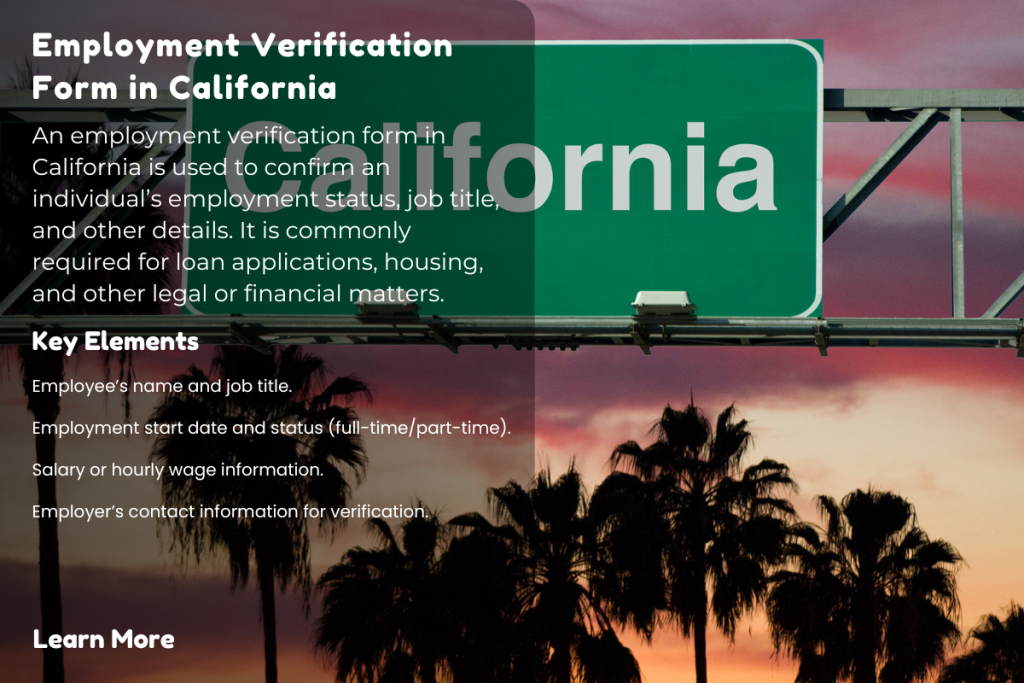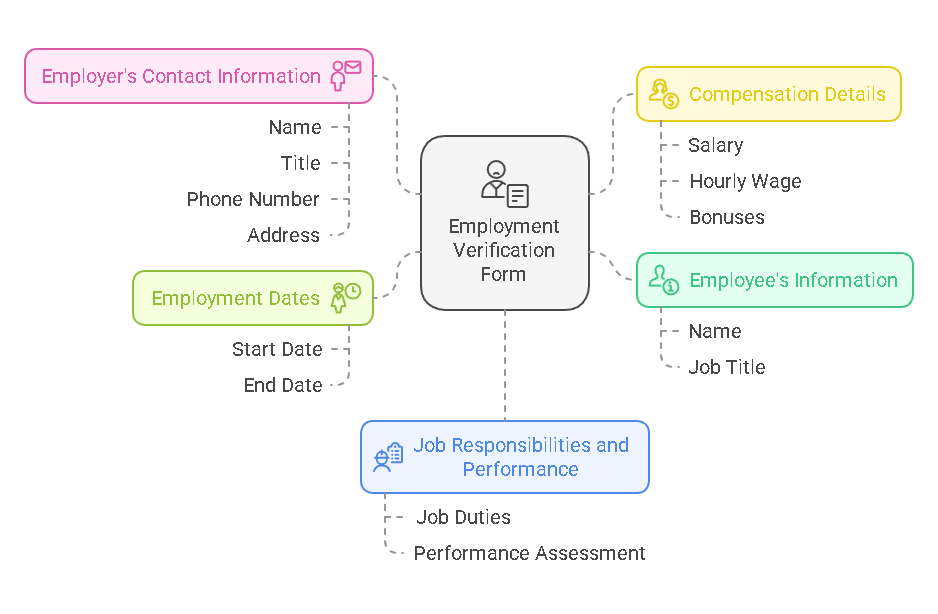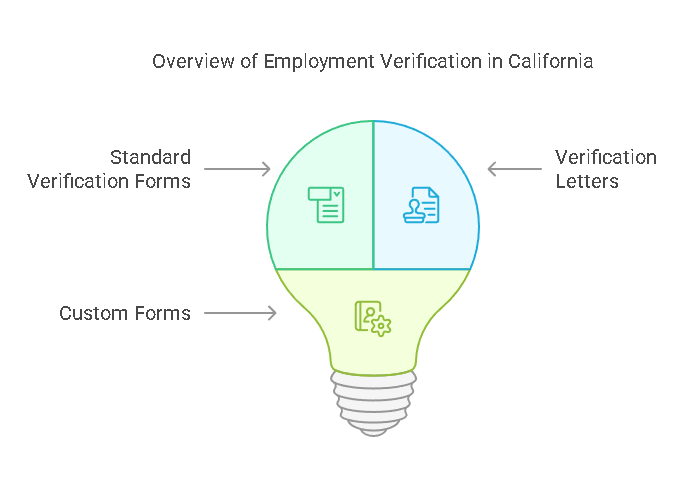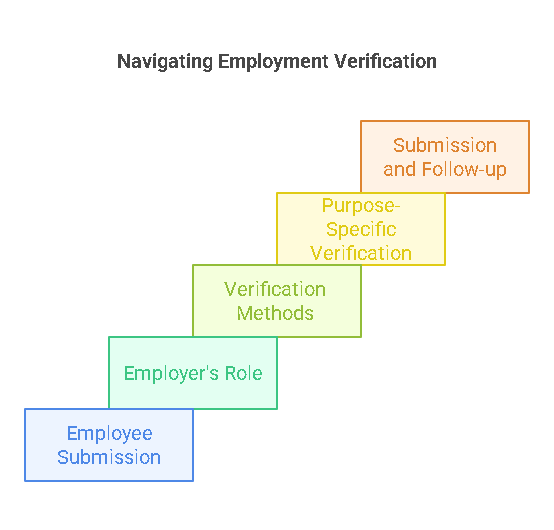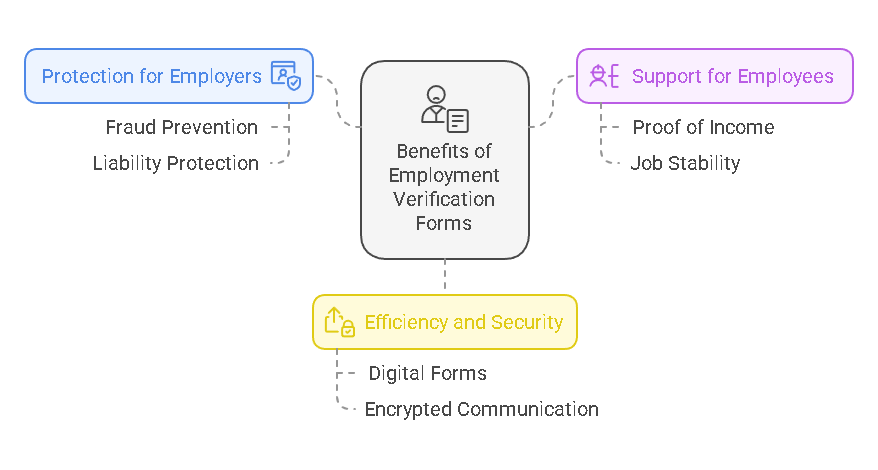The employment verification process in California involves several steps to ensure that the details provided by an employee are accurate and meet the requirements of the requesting party, such as a lender, landlord, or employer. The following is a breakdown of the process:
1. Employee Submission
The first step in the process is for the employee to request an employment verification form from their employer. Depending on the employer’s policy, the request may be made through an online portal, via email, or through direct communication with HR or the employee’s manager. The employee should provide sufficient details about why the form is required (e.g., loan application, rental verification, etc.) so that the employer understands the purpose of the request.
2. Employer’s Role in Completing the Form
Once the request is made, the employer must verify the details provided by the employee. This includes confirming the following:
- Employment Dates: Verifying the employee’s start and end dates, or confirming that they are still employed with the company.
- Job Title and Responsibilities: Clarifying the employee’s role and key responsibilities within the organization.
- Salary or Compensation: Providing information about the employee’s wages, salary, bonuses, and any additional compensation.
The employer is responsible for ensuring that the information provided on the form is accurate, timely, and compliant with applicable labor laws, including privacy regulations.
3. Verification Methods
There are several methods through which the employment verification process can be completed:
- Manual Forms: In some cases, the employee may be required to fill out a physical form or letter, which is then submitted to the employer for completion. This form is typically signed by both the employer and employee.
- Digital Submissions: Many companies now use electronic systems to complete and submit employment verification forms. These digital forms allow for faster processing and eliminate the need for paper-based systems.
- Third-Party Verification Services: In some cases, organizations or institutions will hire third-party verification companies to handle the verification process. These services often provide instant verification and are used by lenders, landlords, and potential employers.
4. Verification for Different Purposes
The employment verification form can be used for various purposes, with different requirements based on the situation:
- Apartment Rentals: When renting an apartment, landlords typically request an employment verification form to ensure the tenant has a stable income that meets the rent requirements. This form can include income details, job stability, and the duration of employment.
- Loan Approvals: Lenders require an employment verification form to assess whether an individual can meet their loan repayment obligations. Banks and other financial institutions may request additional information, such as the applicant’s monthly income, job stability, and employment status.
- Background Checks: Employers use employment verification forms to confirm previous employment and validate a candidate’s work history. This ensures that the information provided during the job application process is accurate and truthful.
5. Submission and Follow-up
After the employer completes the employment verification form, it is returned to the employee or submitted directly to the requesting party. If there are any discrepancies or issues with the form, the employer may need to follow up with the employee or the requesting party for clarification or further documentation.
For example, if the form is used for a loan application and the lender requires additional details or adjustments, the employee may need to work with the employer to resolve the issue. The follow-up process can vary depending on the employer’s policies and the urgency of the verification.
Benefits of Employment Verification Forms in California
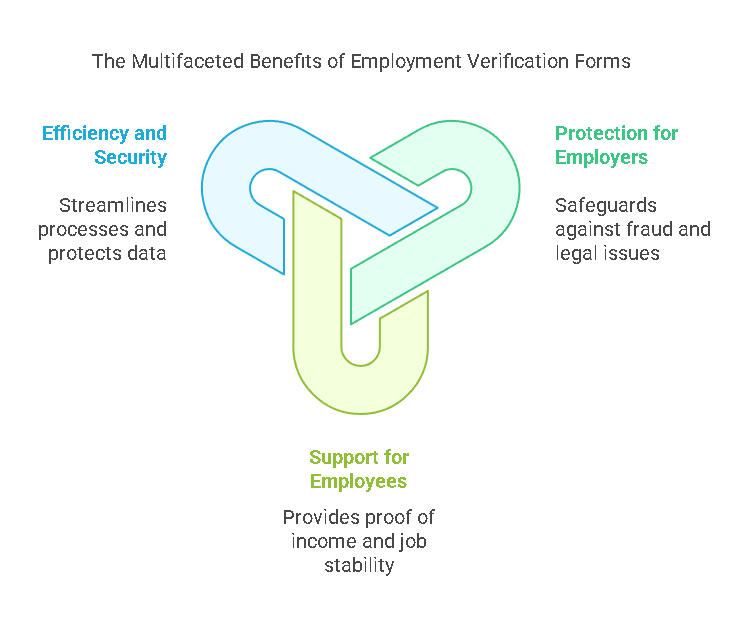
Employment verification forms offer several benefits to both employees and employers, as well as third parties requesting the verification. Below are the key advantages:
1. Protection for Employers
Employers benefit from the use of employment verification forms as they help protect the organization from fraud and misrepresentation. Verifying employment details, including job titles, dates of employment, and salary, ensures that employees are accurately representing their work history. By completing the form, employers safeguard themselves against liability by ensuring they are providing truthful and accurate information to outside parties, such as lenders or landlords.
In addition, using employment verification forms can help prevent legal issues related to incorrect or fraudulent information that could lead to disputes, fines, or damage to an organization’s reputation.
2. Support for Employees
Employment verification forms also provide significant support for employees. These forms allow employees to demonstrate proof of income and job stability, which is often required when applying for loans, renting an apartment, or undergoing a background check. The verification form ensures that employees can provide verifiable evidence of their employment, which can facilitate approvals for financial services or housing.
Furthermore, for employees who may be working with a company for a short time or undergoing career transitions, these forms act as a reliable reference for future employment or personal financial decisions.
3. Efficiency and Security
The employment verification process streamlines several tasks for employers, employees, and third-party organizations. For example, the use of digital forms and third-party verification services can speed up the verification process, ensuring timely approvals for housing applications, loans, and hiring decisions. Digital forms also reduce the risk of errors, ensuring accuracy throughout the process.
Security is another significant benefit of using employment verification forms. By ensuring that only verified details are shared, the form helps protect against fraudulent claims and personal identity theft. Additionally, third-party verification services often provide encrypted communication to maintain the privacy of sensitive information.
Precisehire’s Role in Employment Verification in California
Precisehire plays a crucial role in simplifying the employment verification process, helping businesses in California meet legal requirements, streamline their employee verification procedures, and ensure compliance with state and federal laws. As a trusted provider of background check and verification services, Precisehire offers secure, reliable, and timely employee verification solutions.
By using Precisehire’s platform, businesses can quickly verify an employee’s job history, salary, and other employment details. This is especially important for companies in California, where labor laws and privacy regulations are strict. Precisehire ensures that businesses comply with all regulations, including those related to the Fair Credit Reporting Act (FCRA), and provides employers with the necessary tools to verify the employment history of job candidates or existing employees.
Furthermore, Precisehire’s services streamline the employment verification process for employees, allowing them to quickly and securely provide proof of employment for various purposes, including housing, loans, or background checks.
Benefits of Using Precisehire’s Employment Verification Services:
- Compliance with California Employment Laws: Precisehire ensures that all verification forms and background checks are completed in compliance with California’s strict labor and privacy laws.
- Fast and Accurate Results: With Precisehire, businesses and employees can receive verification forms quickly and accurately, reducing delays in the verification process.
- Security: Precisehire uses secure, encrypted platforms to protect sensitive employee information during the verification process.
- Streamlined Process: By automating and digitizing the verification process, Precisehire reduces manual errors and speeds up the overall workflow.
Comparison Table: Employment Verification Methods
| Verification Method |
Advantages |
Disadvantages |
| Manual Forms |
Simple to use, well-established process, no technology needed |
Time-consuming, prone to human error, not scalable |
| Digital Submissions |
Faster, more secure, eliminates paperwork, easy to store |
Requires access to technology, may require employee training |
| Third-Party Verification |
Instant results, highly secure, handles multiple verification types |
Can be costly, dependent on third-party services |
Legal Aspects of Employment Verification in California
Employment verification forms are not just administrative documents; they are governed by various state and federal regulations that protect the rights of employees and employers. Understanding the legal aspects of these forms is crucial to ensuring compliance and avoiding penalties.
State and Federal Laws Governing Employment Verification in California
California law, along with federal regulations, dictates how employment verification forms must be handled. Employers must ensure that they comply with these laws to avoid legal repercussions. Key laws include:
- Fair Credit Reporting Act (FCRA): The FCRA governs the use of background checks and employment verifications in the United States. It requires employers to obtain written consent from employees or job candidates before obtaining employment verification through third-party services. It also mandates that employees be notified if the information obtained from the verification process will be used against them (such as in the hiring process).
- California Labor Code: In California, the Labor Code outlines specific requirements for employment-related documentation, including employment verification forms. It mandates that employers provide certain information regarding wages and job status, but it also protects employees’ rights to privacy in their employment records.
- California Consumer Privacy Act (CCPA): The CCPA is a state law that enhances privacy rights and consumer protection. Under this law, employees have the right to access information that employers collect about them, including employment verification data. Employers must comply with the CCPA when handling personal data.
Employer Obligations
Employers in California must meet specific obligations when providing employment verification forms:
- Accuracy and Timeliness: Employers must ensure that the information provided on the employment verification form is accurate and up to date. Employers should respond to requests for verification in a timely manner, typically within a few days. Failure to do so could lead to delays in the hiring or rental process for employees.
- Confidentiality: Employers must protect the privacy of their employees when handling personal information. They cannot disclose details of employment to third parties without the employee’s consent unless required by law (such as for a background check or court order).
- Non-Discrimination: Employers cannot discriminate against employees or job candidates based on their race, gender, or other protected characteristics when providing employment verification forms. They must treat all employees equally in the verification process.
Employee Rights
Employees in California have specific rights related to employment verification forms:
- Right to Request Information: Employees can request to see the information that is being submitted on their behalf. If the information is inaccurate, they have the right to request corrections.
- Right to Privacy: Employees are entitled to privacy concerning their employment information. Employers must ensure that sensitive data is protected and shared only with authorized parties, such as landlords or loan officers, who have legitimate reasons to request the verification.
- Right to Dispute Inaccurate Information: If employees discover that their employment verification form contains incorrect information, they can dispute the accuracy of the details. Employers must investigate the claim and provide a corrected version if necessary.
Penalties for Non-Compliance
Employers who fail to comply with the legal requirements related to employment verification can face several penalties:
- Fines: Employers may be subject to monetary fines for failure to provide verification forms in a timely or accurate manner.
- Legal Action: Employees can file lawsuits if an employer does not comply with legal requirements, such as failure to provide verification within the mandated time or if personal information is improperly shared.
- Reputational Damage: An employer’s reputation can suffer if they fail to comply with the verification process, especially when employees feel their privacy has been violated.
How to Handle Disputes
Disputes may arise if an employee believes there is a mistake or omission on the verification form. Here’s how to handle such disputes:
- Employee-Employer Communication: If an employee notices discrepancies, they should notify their employer promptly. Clear communication is essential for resolving the issue.
- Review and Correction: Employers should review the disputed information and correct any inaccuracies. If the error is confirmed, the updated form should be provided to the employee or third-party requester.
- Mediation: If the dispute cannot be resolved directly between the employee and employer, they may seek assistance from an external mediator to reach a resolution.
Frequently Asked Questions
An employment verification form in California is a document that confirms the employment status, income, and job history of an individual. It is commonly requested by landlords, loan officers, or prospective employers to verify the applicant’s income and employment history.
Employees can request an employment verification form from their employer by contacting the human resources (HR) department. The request can often be made via email, phone, or in writing. Employees should clearly indicate the purpose for which the verification is needed.
Yes, landlords often require employment verification as part of the rental application process. The form serves as proof of income, helping landlords assess whether tenants can afford rent.
The completion time for an employment verification form varies. On average, employers should provide the form within a few business days. However, it may take longer depending on the employer’s workload or the complexity of the request.
No, it is not legal for employers in California to charge employees for completing an employment verification form. Providing this form is part of the employer’s obligations, and employees should not be required to pay for it.
Conclusion
Employment verification forms are essential for confirming an individual’s job history, income, and employment status. In California, these forms play a critical role in various processes such as background checks, housing applications, and loan approvals. Both employers and employees must understand their rights and responsibilities to ensure compliance with state and federal laws.
Employers are legally obligated to provide accurate and timely verification, while employees are entitled to request corrections if discrepancies arise. Non-compliance with verification requirements can lead to legal penalties and damage to reputation.
For employers looking to streamline their verification process and ensure compliance with California’s legal requirements, Precisehire offers a comprehensive solution. The platform simplifies the employment verification process, providing businesses with reliable, timely, and secure verification services to ensure smooth background checks and legal compliance.
